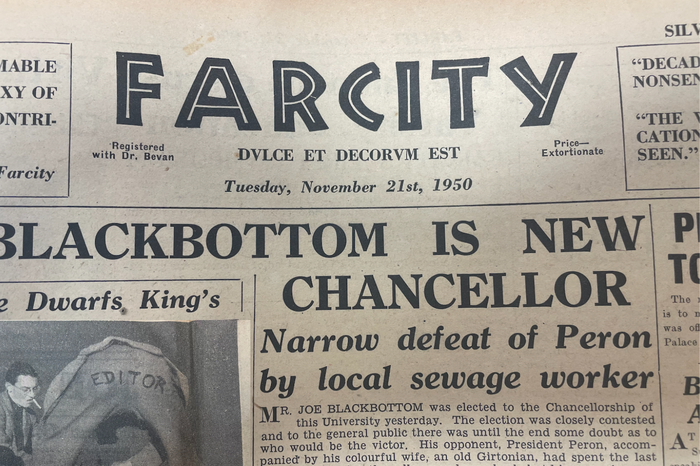Vintage Varsity: one small step for Cambridge
Resident Archivist Eleanor Dougan investigates Cambridge’s stance on lunar travel over the decades

The mystery of what lies beyond our earthly existence in outer space – and how we can get there – has plagued human minds throughout history, and, of course, has long been pondered here in Cambridge.
In November 1950, Varsity interviewed a group of Cambridge scientists who had just watched a preview of ‘Destination Moon’, a new film offering “Hollywood’s first serious report on the possibilities of lunar exploration”. The scientists praised the film as “good entertainment in the true American fashion”, despite the “minor inaccuracies” and “large number of suppositions”. One research student told Varsity that “non-scientists will probably find much of the film dull”.
“A porter denounced ‘the arrival of shreds of another planet’ to Cambridge as ‘boring and a waste of money’!”
An astronomer, P.C. Price, remarked that the concept of lunar travel “cannot be dismissed as fanciful” since “it may easily be accomplished within the next thirty years”. While he was a decade off, it is evident that trips to the moon were on the minds of Cambridge’s brightest astronomical experts as part of the near future. He also commented that it is uncertain whether “conditions in interplanetary space would permit the travellers to venture outside the rocket in safety” – Armstrong and Aldrin famously proved this possible nearly twenty years later.
After a groundbreaking summer of men on the moon, in October 1969 Varsity reported on the research being carried out in Cambridge with ‘moondust’. They discussed this with Dr Agrell who had brought the moondust from America himself to Cambridge with a police escort. He described the moondust as “like clinker”, and noted that “although Cambridge’s specimen is worth about five million pounds, only a nutter would want to steal it”.
The moondust was kept at the Department of Minerology and Petrology on the Downing Site for a three-month examination to determine the composition of the minerals, as well as the conditions which would produce the chemical structure of the rock. Agrell informed Varsity that he was “excited by actually working on the moon” but did not “subscribe to a false mystique” of mystical moondust.
Despite this excitement over on the Downing site, a porter denounced “the arrival of shreds of another planet” to Cambridge as “boring and a waste of money”! Varsity also revealed that a lampshade shop on Bridge Street was offering a globe-shaped lamp to the winner of a contest guessing “which part of the earth their phial of dust comes from”.
Nowadays, space travel is preoccupying Cantabrigians just as much as ever: in February 2023, Varsity spoke to CU Spaceflight, a society aiming to launch a rocket beyond the Karman line (the beginning of outer space) and “become the first European student team to reach space”. In the 2023 interview, the team were making “good progress” on ‘Griffin I’ thanks to external financial support, and planned to launch their rocket to an altitude of 150 km in 2024. Although this is yet to occur, there are still a few weeks left in 2024, and the group’s website optimistically affirms that they “get nearer to the Karman line each day”.
 News / Uni Scout and Guide Club affirms trans inclusion 12 December 2025
News / Uni Scout and Guide Club affirms trans inclusion 12 December 2025 News / Pembroke to convert listed office building into accom9 December 2025
News / Pembroke to convert listed office building into accom9 December 2025 Features / Searching for community in queer Cambridge10 December 2025
Features / Searching for community in queer Cambridge10 December 2025 News / Uni redundancy consultation ‘falls short of legal duties’, unions say6 December 2025
News / Uni redundancy consultation ‘falls short of legal duties’, unions say6 December 2025 News / Cambridge Vet School gets lifeline year to stay accredited28 November 2025
News / Cambridge Vet School gets lifeline year to stay accredited28 November 2025









